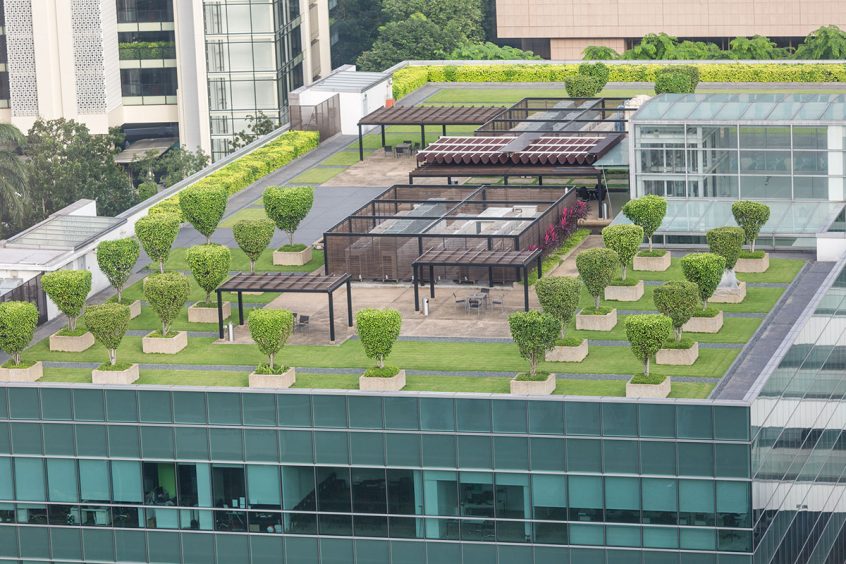Water stains on the ceiling, condensation droplets, the resulting mold growth and increased heat losses are just a few of a long list of problems that are often caused by the improper construction of flat roofs. To have a sustainable and energy efficient roof, careful consideration must be given to its implementation, even though this may sometimes lead to a different approach to construction.
With all structures that are exposed to sunlight, temperature variations, water or mechanical damage, a basic rule must be observed: they must be built in such a way and with such materials that the structure can resist all atmospheric threats.
It sounds simple.
We should design and construct a building much the same way as planning and choosing our clothes. Season and weather appropriately, we seeking protection from rain with an umbrella or raincoat, and by wearing light summer clothes in summer. A building, including its roof, however, can be only “dressed” once. Therefore, we should wrap it in layers and choose a method that will permanently protect it from all weather conditions.
Waterproofing is like skin. If left unprotected and exposed to the sun for too long, it will never recover.
Unfortunately, in real life we find different interpretations of how to achieve durability. Examining, for example, the classic implementation of a flat roof, we see that the water protecting layer, or waterproofing, is left unprotected. Of course, we find that the building is, indeed, protected from atmospheric moisture. However, we also notice that due to increased exposure to temperature changes and mechanical factors, such as hail or UV-rays, the material wears faster and, finally, cracks. Unfortunately, repair, other than partial restoration with stepping on the already hardened and non- elastic waterproofing, usually makes things worse.
Inverted roof for durability and extra – free of charge – square meters
Diligent planning of the roof implementation is the only way to protecting your building from external factors, as well as yourself from worries of constant repair. Because you want your roof to hold water permanently and at the same time to protect you from the summer heat and the winter cold, you should, besides waterproofing, carefully consider the installation of proper thermal protection.
Durable waterproofing = durable roof
Roof durability is achieved by protecting the waterproofing against damage from UV rays and temperature changes, as these accelerate aging and leave the waterproofing brittle. Special thermal insulation made of extruded polystyrene, which does not absorb water and keeps its insulating capacity even during precipitation and constant humidity, is a good choice.
This thermal insulation acts as a foam protection, while it is strong enough to withstand walking, driving or the exertion of other loads (picture or drawing of the flat face of the roof).
Roofs constructed according to these standards are regularly used in large buildings, where investors, after a few years, cannot afford the huge repair costs. Unfortunately, in smaller buildings, ignorance is still the reason for installing waterproofing the risky old way.
An inverted roof can prolong the useful life of your flat roof for a few lifetimes without fearing external influences.
In construction, the described method of achieving lasting waterproofing stability is called an inverted roof. It prevents unnecessarily quick wear and tear of the waterproofing material from the influence of external factors. This is how waterproofing can remain flexible for a long time, and sometimes its lifetime can be as long as the lifetime of its building.
Thermal insulation – the way to zero-energy buildings
As regulated by the upcoming EU legislation, the development of flat roofs focuses on sustainable and energy-efficient solutions. All public buildings constructed after 2018 should observe the EU directives and comply with the prescribed nearly zero-energy standards. After 2020, the same regulation will apply to all other new construction, as well as to retrofitted buildings.
The inverted roof is, therefore, a simple solution for all buildings, while it is especially suited for low energy buildings. Investors in buildings with flat roofs can benefit twice from their new construction: they have a durable and versatile roof, and gain additional residential area – with no extra cost. Also, non-leaking roofs can be renovated without touching the existing structure, using well thought out measures to achieve sustainable, energy efficient, and, last but not least, new useful floor space, thus increasing the long-term quality of indoor life.
What about you? Are you planning to build a new house or do you want to improve your living comfort under your existing flat roof? We put together a few tips:
Expert advice: How to build a green roof:
Especially in cities, green roofs are on a fast track to popularity. Green roofs help reduce environmental burdens and provide for a better atmosphere. If you want to turn your flat roof into a green roof, you need to ensure a good drainage and protect your waterproofing from plant root damage. When constructing a flat roof, do not forget to consider the extra load due to a layer of soil and the water that it will absorb later on.
Look for more ideas on how to create your own idyllic place on the roof in the free document The inverted flat roof for your dream home under the clouds.

 +386 7 39 39 510
+386 7 39 39 510 advice@energyshield.biz
advice@energyshield.biz

